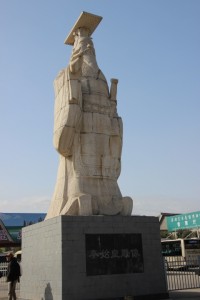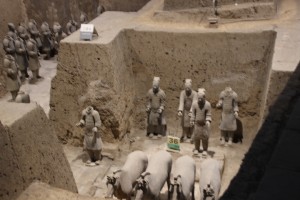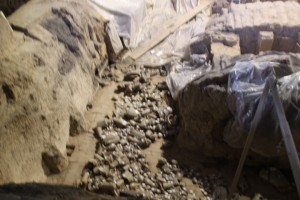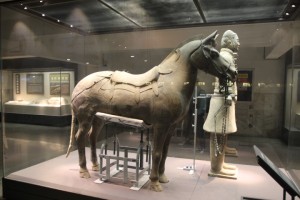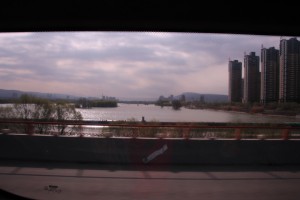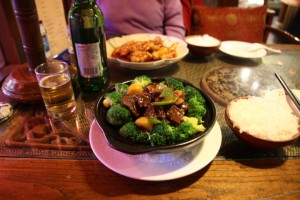Thursday 10th March
Today has broken as a much better day than yesterday. It is certainly crisp but we can see the blue sky!
Today’s mission is to see what has been described as ‘the Eighth Wonder of the World’: The Emperor Qin Shihuang Mausoleum Site Museum or more commonly known as the Terra-Cotta Army (Eng. Army of Terracotta Warriors).
This is an underground vault of earth, mud and timber that eventually yielded more than 8000 life-size terracotta soldiers and their horses in battle formation. It was an accident in1974 when farmers digging a well uncovered a soldier and remains of weapons thinking that they may be the remains of a local tile making industry. But when archaeologists were informed the findings turned out to be a/the most major archaeological discovery of the 20th century. The army is like a well preserved and always vigilant force standing by as a guard to the Emperor’s resting place which is towards the hills nearby.




There are three vaults containing figures and remains of weaponry and a chariot. Bronze chariots and horses were also unearthed near Emperor Qin’s tomb.
The biggest vault is some 210m by 60m and with a depth of 5-7m with walls of buildings running east to west at intervals of 3m forming corridors. It is in these corridors that the figures are arranged standing on grey brick. There is evidence of pillars and beams that once supported the roofs of these buildings. The whole complex is covered with an arching steel roof making this a vast auditorium bigger than any football stadium!
There are 6000 figures of warriors and some horses in battle formation and facing east. There are three rows of 210 crossbow and longbow bearers acting as the vanguard (at the front). Behind is the main force of soldiers with spears, daggers, axes and poleaxes all accompanied by 35 horse drawn chariots most of which were made of wood and therefore have long since disintegrated but small parts remain including a wheel preserved in mud. The archers have their bodies and limbs positioned as if they were about to take to the battlefield and body armour, like chainmail but containing small pieces of stone is worn by some soldiers.
There is some speculation that the sculptors used themselves and work colleagues as models for the warriors. Archaeologists found that many of the figures held real weapons of 2000 years ago which had their surfaces treated to protect them from rust, so that after being buried for more than 2000 years they were still sharp! The weapons are stored in a non-public area.
By 1976 another pit containing about 1000 figures was unearthed and later a third pit which contained 68 soldiers and a chariot. It is thought by experts that these findings may only be ‘the tip of the iceberg’ and future work over the decades may give us the answer.
All of this is in the countryside about 40 minutes from Xi’an. It is another good example of how China’s past is open to the public but the trappings of tourism do not spoil what everyone is there to see. Thousands of tourists at this site can be handled with ease.
After a few hours of exploration one of the members of the team found time to sample a new found Chinese delight – lime flavoured crisps! They taste better than they sound!
Xi’an is the start of one of The Silk/Spice Routes and as a result produce for centuries has been handled by traders through the city. We would like to share with you some of the delights of the mystic east and the city at night. We ate in a restaurant we discovered yesterday, however, this evening a member of the team was really, really taken by one of the main courses entitled ‘delicious lurou’. In other words spicy donkey stew!!
These photographs cannot convey the mixture of sounds and smells that permeate the whole area.
This trader has peeled and sculptured the pineapple and is now cutting them in half and quarters hoping for a rapid sale.

